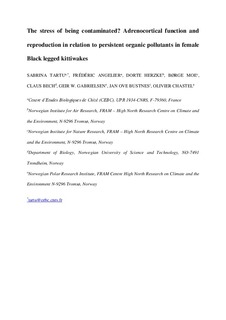| dc.contributor.author | Tartu, Sabrina | |
| dc.contributor.author | Angelier, Frédéric | |
| dc.contributor.author | Herzke, Dorte | |
| dc.contributor.author | Moe, Børge | |
| dc.contributor.author | Bech, Claus | |
| dc.contributor.author | Gabrielsen, Geir W. | |
| dc.contributor.author | Bustnes, Jan Ove | |
| dc.contributor.author | Chastel, Olivier | |
| dc.date.accessioned | 2018-01-23T17:57:14Z | |
| dc.date.available | 2018-01-23T17:57:14Z | |
| dc.date.created | 2014-02-04T11:53:41Z | |
| dc.date.issued | 2014 | |
| dc.identifier.citation | Science of the Total Environment. 2014, 476-477 553-560. | nb_NO |
| dc.identifier.issn | 0048-9697 | |
| dc.identifier.uri | http://hdl.handle.net/11250/2479207 | |
| dc.description.abstract | High levels of environmental pollutants such as persistent organic pollutants (POPs) including PCB and DDT have been found in the Arctic and many of those pollutants may impair reproduction through endocrine disruption. Nevertheless, their effects on stress hormones remain poorly understood, especially in free-ranging birds. Corticosterone, the principal glucocorticoid in birds, can indirectly impair reproduction. The aim of the present study was to examine the relationships between POPs and reproduction through their potential consequences on different reproductive traits (breeding decision, egg-laying date, breeding success) and corticosterone secretion (baseline and stress-induced levels). We addressed those questions in an Arctic population of female black-legged kittiwakes during the pre-breeding stage and measured several legacy POPs (PCBs and pesticides: HCB, p,p′-DDE, CHL) inwhole blood. POP levelswere not related to breeding decision neither to breeding success, whereas females with high levels of pesticides laid their eggs earlier in the season. We found a negative relationship between POP levels and body condition index in non-breeding females. Black-legged kittiwakeswith higher levels of PCB showed stronger adrenocortical responsewhen subjected to a capture-handling stress protocol. We suggest that PCBsmay disrupt corticosterone secretion whereas the positive relationship between pesticides and egg-laying date could either originate from a direct effect of pesticides or may be related to other confounding factors such as age or individual's quality. Although no direct negative reproduction output of POPs was found in this study, it is possible that the most contaminated individuals would be more sensitive to environmental stress and would be less able to maintain parental investment than less polluted individuals. | nb_NO |
| dc.language.iso | eng | nb_NO |
| dc.rights | Attribution-NonCommercial-NoDerivatives 4.0 Internasjonal | * |
| dc.rights.uri | http://creativecommons.org/licenses/by-nc-nd/4.0/deed.no | * |
| dc.title | The stress of being contaminated? Adrenocortical function and reproduction in relation to persistent organic pollutants in female black legged kittiwakes | nb_NO |
| dc.type | Journal article | nb_NO |
| dc.type | Peer reviewed | nb_NO |
| dc.description.version | acceptedVersion | nb_NO |
| dc.source.pagenumber | 553-560 | nb_NO |
| dc.source.volume | 476-477 | nb_NO |
| dc.source.journal | Science of the Total Environment | nb_NO |
| dc.identifier.doi | 10.1016/j.scitotenv.2014.01.060 | |
| dc.identifier.cristin | 1109031 | |
| dc.relation.project | Norges forskningsråd: 234423 | nb_NO |
| cristin.unitcode | 7511,2,0,0 | |
| cristin.unitcode | 7511,4,0,0 | |
| cristin.unitname | Avdeling for terrestrisk økologi | |
| cristin.unitname | Tromsø | |
| cristin.ispublished | true | |
| cristin.fulltext | postprint | |
| cristin.qualitycode | 2 | |

